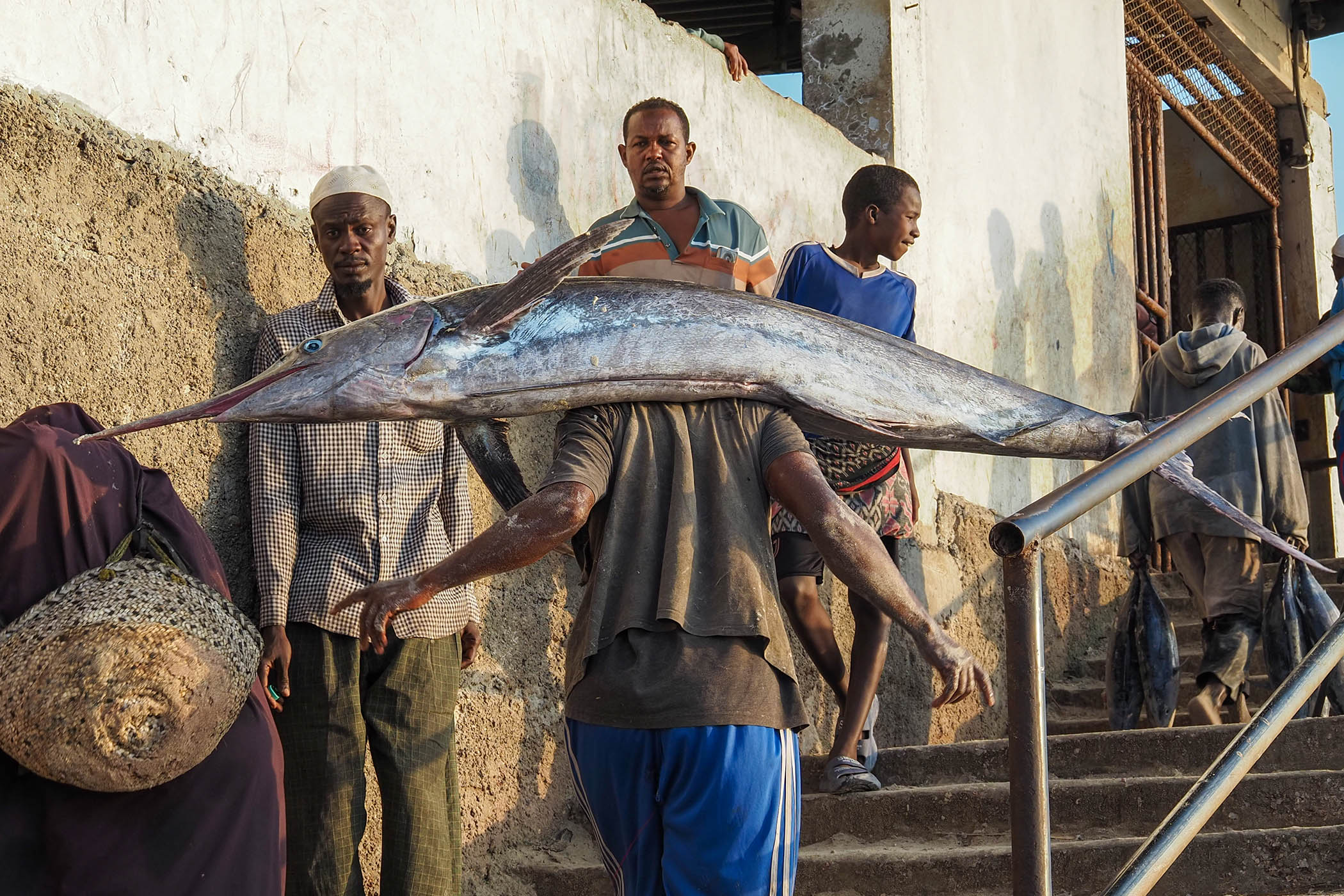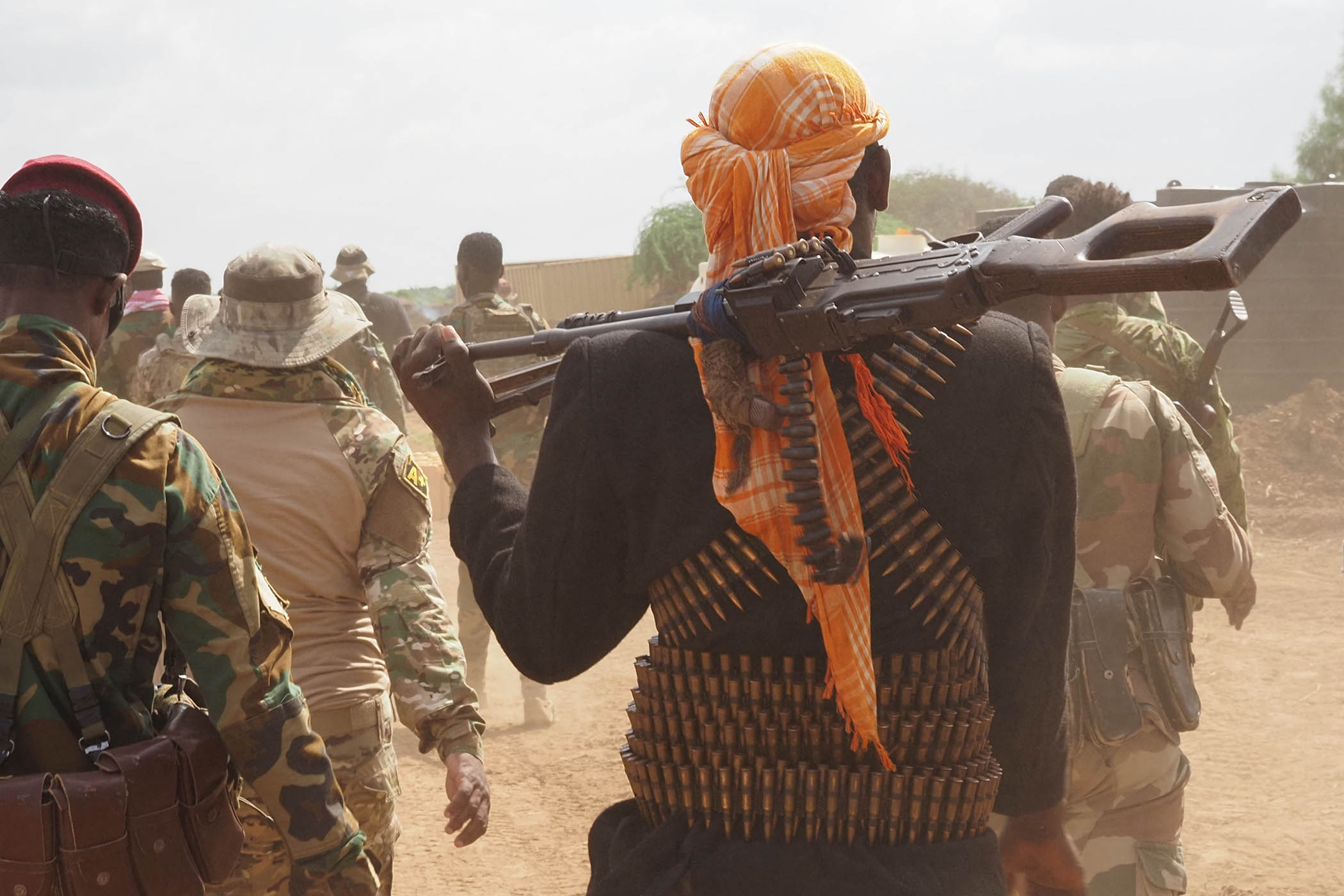The Somali government’s grip on power slips with each town the Shebelle River passes southwest of Mogadishu, its waters veering into banana plantations and the rural heartlands of al-Shabaab.
First, Sabid, a town safe enough for Turkish troops to snap selfies near the bridge they helped rebuild. Second is Bariire, where terrorist insurgents blew up two bridges and left informants lurking among the population.
The third, Awdheegle, is the last bastion of government control, 30 miles away from the capital. A large swathe of the town is still marred by burnt and twisted metal, remnants of the type of homemade bomb favoured by al-Shabaab, the militant Islamist group. If it had not detonated accidentally during construction, the weapon may have been fated for a terror attack in Mogadishu.
After months of heavy fighting, insurgents retreated from Awdheegle in early October and left it to the Somali National Army (SNA) and its allies. It is now held by about 1,000 SNA soldiers and a contingent of Ugandans, but their control is tenuous.
Within minutes of Lt Col Abdirahim Mohamed Munye reassuring The Observer that his forces have secured the town, troops and government handlers rush through Awdheegle to end the visit. The Ugandan helicopter pilots providing transport are anxious to leave, saying al-Shabaab usually starts lobbing mortars when they have been on the ground this long, while angry locals have begun crowding around government officials, demanding support.
It all adds to a sense of chaos on a 360-degree frontline where insurgents could lie just a 100 metres out of town, despite the government’s insistence it has control of the capital’s hinterlands.
“Three hundred kilometres from Mogadishu, the whole area is secure,” says Awes Hagi, the federal government’s national security adviser. “We are 100% sure that Shabaab will never seize [the capital].”

A man carries a catch into one of Mogadishu’s main fish markets
In fact, al-Shabaab has quietly taken over much of rural central and southern Somalia this year while the world’s attention has been on Ukraine and Gaza. The al-Qaida affiliate, which seeks a caliphate in the Horn of Africa is now estimated to hold about 30% of the country and is at the gates of Mogadishu.
“Al-Shabaab remain in significant numbers in the countryside around Mogadishu,” says Matthew de Waal, an analyst at Sahan Research, a thinktank with sources across Somalia. “The guerrillas are everywhere. It’s like the Vietnam war.”
Although al-Shabaab is massing forces beyond Awdheegle and digging in around the city, analysts increasingly believe the group will not launch a full-scale attack on Mogadishu. It is more likely it will try to topple the capital from within – and may even attempt to seize power like terrorist groups-turned-governments in Afghanistan and Syria.
“It doesn’t control any cities,” says Tricia Bacon, a professor at American University and terrorism specialist. “And neither did the Taliban. Until it did.”
Even with its bombed-out and bullet-pocked buildings, Mogadishu is beautiful, and residents say life in the capital has not been this vibrant in years. Gunshots and explosions, once a daily occurrence, are now rare, and people fearlessly roam the streets and markets that were once terrorist targets. The city’s beaches are busy even on weekdays, and there is vibrant street nightlife rivalling that of other East African capitals.
“I’m not afraid of the threat of extremism to stop me from studying,” says Sumayo Noh Abdi, a student. “We believe it is just propaganda,” she says of reports al-Shabaab has encircled the city.
Crowds flock to the fish markets at dawn. Without the infrastructure to process, package and refrigerate – let alone export – fish, they must be eaten rapidly, with entire yellowfin tuna selling for as little as $5.
“The security has improved. There are police and army everywhere. If the security situation worsens, that will definitely impact my business,” says Ibrahim Osman Adani, a fisherman.
The security apparatus that has made the city safer is also evidence of the enduring threat. Armed men gather on street corners and there are few other capitals that see so many truck-mounted machine guns in rush hour traffic. Checkpoints guard roads to the city, where cars are searched and papers scrutinised.
There is an argument that security has only improved in Mogadishu because al-Shabaab allows it, and that greater government control of the city portends its very downfall. As President Hassan Sheikh Mohamud, known as HSM, has consolidated power, analysts say he has made enemies in the capital through evictions – seen as land grabs – and efforts to disarm local militias.

A soldier from the Somali National Army in the bridge town of Sabid
Al-Shabaab is explicitly trying to tap into this discontent, according to de Waal, and is reaching out to clan elders and key politicians to build support against the government.
“The more the political conflict becomes heightened, the more al-Shabaab try to take advantage,” says Ahmed Isse Awad, Somalia’s former foreign minister and ambassador to the US, now an opposition politician.
Somalia’s descent began in 1991 after the collapse of its military dictatorship and a subsequent civil war that tore the country apart. It went almost two decades without a functioning government, despite – or, some Somalis say, because of – sustained western involvement, much of which was focused on anti-terrorism. In the 2000s, the US and UK viewed Somalia as the third front in the so-called “war on terror”.
Successive Somali administrations have fought al-Shabaab since it emerged as a youth militia in the 2000s. The group briefly held sway over Mogadishu in 2011 before a western-backed intervention by African Union (AU) forces.
In the decade and a half since, al-Shabaab has remained a powerful insurgent force, but it was not until earlier this year that it began to threaten the capital once again. In an offensive launched during Ramadan in the spring, insurgents swept across Somalia’s centre and south. Al-Shabaab seized the towns to Mogadishu’s south-west and raided north-western towns even closer to the city.
The militants’ success is a textbook study in how the absence of institutions mixed with a political culture of strongmen breeds violent extremism.
“Al-Shabaab is the result of a failed state and a vacuum of governance,” says Awad. “They are a symptom of the situation of the country – but now al-Shabaab has also become a cause.”
Somalia’s latest strongman is now looking to extend his grip on power. HSM’s term ends in May, and he looks to be agitating for either a two-year extension or a radical overhaul of Somalia’s electoral system.
The president’s opponents view the proposed reforms as a chance for him to commit election fraud, and de Waal’s research supports the claim that some voters who have been signed up under the new electoral plan are underage children. “In the United States they also claim election fraud here, fraud there,” says Yusuf, the presidential adviser.
A decline in the Mogadishu regime’s legitimacy could also threaten the international funding that keeps threadbare services operating. “There are reductions in funding globally that are also affecting Somalia,” says Charles King, the UK’s ambassador in Mogadishu. “In that context, I think it’s even more important that the Somali government can demonstrate that there is a clear way forward, politically.”
The UK remains one of the most engaged international players in Somalia. “There is an enduring terrorist threat from Somalia in the form of al-Shabaab and Islamic State in the north, and that impacts UK and regional interests,” King says. “We are committed to addressing that.”
With investment of more than £20m announced in September, the UK is also a rare western player to have firmed up new funding for security efforts this year.
“There’s not a lot of appetite for this kind of conflict anymore,” says Bacon.
Crucially, the AU mission, without which the Somali government would not survive, is $94m in arrears and requires another $196m to fund operations this year.

Women walk through the rubble of Awdheegle, a town Al-Shabaab has controlled many times in 20 years
Efforts by HSM to consolidate and centralise power are meanwhile tearing the country apart. The federal states of Puntland and Jubaland cut ties with Mogadishu last year, and there is evidence, which the government denies, that HSM diverts resources, that could be used against al-Shabaab, to fight political opponents.
“There are scenarios where al-Shabaab launches a sophisticated campaign of encircling Mogadishu, hitting targets within it, getting key defections, while the government is focused on fighting its political rivals,” says Bacon.
Al-Shabaab is thriving in this chaos. With no united front in its way, the group could also find inspiration in the progress of another group linked to al-Qaida – the remarkable trajectory of Ahmed al-Sharaa in Syria.
After al-Sharaa’s Hayat Tahrir al-Sham (HTS) swept into Damascus last December and toppled the Assad regime, it swiftly rebranded itself as an inclusive government that could bring the country back together. “If Shabaab changed from al-Qaida … then they don’t even need to fight,” says Awad, the former foreign minister, suggesting enough Somalis may feel al-Shabaab are an acceptable government.
‘Al-Shabaab doesn’t control any cities. And neither did the Taliban. Until it did’
Prof Tricia Bacon
The success of HTS was not dissimilar to the Taliban’s recapture of Kabul in 2021, both being groups that many would label as terrorists taking control of entire countries. Can al-Shabaab be next?
“They have already demonstrated significant governance capability. I do think al-Shabaab saw the prospects of what happened in Afghanistan and Syria. It has made something possible that at one time they didn’t think was possible,” says Bacon. “The government will either assume it will be saved by the international community, which I think is a dubious assumption, or miss the signs until it’s too late.”
Yusuf outlines plans to push past Awdheegle further into Lower Shabelle – once areas closer to Mogadishu from the north and west are secure. Before it has that chance, the SNA may be on the defensive again. It is believed that al-Shabaab may crank up the pressure in the coming weeks with attacks on Mogadishu and outlying bases.
“SNA is just a ragtag army,” says Awad. “They don’t have doctrine and they don’t have structure. Our SNA cannot defeat Shabaab the way it’s managed.”
In Awdheegle, SNA soldiers clad in colourful T-shirts hugged tight by bandoliers show off battlefield antics in TikTok form – really just boys in the back of a truck, nodding their head to ubiquitous social media soundtracks. “If they come at us again, we will get them together and blow them up,” one of them says, smiling and gesturing an explosion with his hands.
Their Ugandan comrades are more stoic. “If you look at our dead you will understand that al-Shabaab are good fighters,” said a senior Ugandan soldier. “We are better trained, but they fight to die.”
Suicidal tactics belie al-Shabaab’s desire to survive – and return.
The government plan to retake Awdheegle involved scouting by SNA and Ugandan forces ahead of pounding airstrikes and a wider advance, according to a source familiar with the details. To the vanguard’s surprise, when they entered the town, they found al-Shabaab gone without a trace.
“It’s not the first time Awdheegle has been liberated,” said the source. “If you look at history, al-Shabaab will get it back.”
Awdheegle’s bridge was left untouched, the only one in the three river towns not blown by al-Shabaab in its retreat.
“I know they are still around Awdheegle,” says Ahmed Abdulrahim, a farmer. “But I am not scared.”
Photographs by Jack Denton
